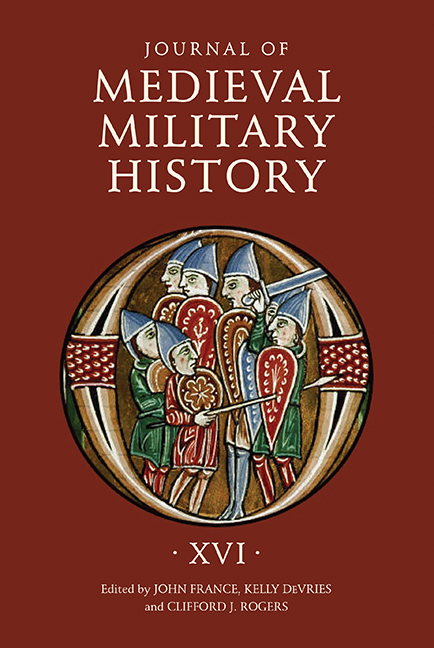Book contents
- Frontmatter
- Contents
- List of Illustrations
- 1 In the Field with Charlemagne, 791
- 2 The Recruitment of Freemen into the Carolingian Army, or, How Far May One Argue from Silence?
- 3 Baybars’ Strategy of War Against the Franks
- 4 Food, Famine, and Edward II's Military Failures
- 5 The Impacts of Warfare on Woodland Exploitation in Late Medieval Normandy (1364–1380): Royal Forests as Military Assets during the Hundred Years’ War
- 6 Exercises in Arms: the Physical and Mental Combat Training of Men-at-Arms in the Fourteenth and Fifteenth Centuries
- 7 The Skirmish: A Statistical Analysis of Minor Combats during the Hundred Years’ War, 1337–1453
- 8 Yron & Stele: Chivalric Ethos, Martial Pedagogy, Equipment, and Combat Technique in the Early Fourteenth-Century Middle English Version of Guy of Warwick
- 9 Reframing the Conversation on Medieval Military Strategy
- List of Contributors
- Journal of Medieval Military History 1477–545X
1 - In the Field with Charlemagne, 791
Published online by Cambridge University Press: 09 October 2019
- Frontmatter
- Contents
- List of Illustrations
- 1 In the Field with Charlemagne, 791
- 2 The Recruitment of Freemen into the Carolingian Army, or, How Far May One Argue from Silence?
- 3 Baybars’ Strategy of War Against the Franks
- 4 Food, Famine, and Edward II's Military Failures
- 5 The Impacts of Warfare on Woodland Exploitation in Late Medieval Normandy (1364–1380): Royal Forests as Military Assets during the Hundred Years’ War
- 6 Exercises in Arms: the Physical and Mental Combat Training of Men-at-Arms in the Fourteenth and Fifteenth Centuries
- 7 The Skirmish: A Statistical Analysis of Minor Combats during the Hundred Years’ War, 1337–1453
- 8 Yron & Stele: Chivalric Ethos, Martial Pedagogy, Equipment, and Combat Technique in the Early Fourteenth-Century Middle English Version of Guy of Warwick
- 9 Reframing the Conversation on Medieval Military Strategy
- List of Contributors
- Journal of Medieval Military History 1477–545X
Summary
After deposing his first cousin, the Bavarian duke Tassilo, at the royal palace of Ingelheim in 788, Charlemagne came to Regensburg in Bavaria and secured its borders against the Avars, a semi-nomadic people who lived to the east in what is now Lower Austria and Hungary. He then celebrated Christmas at Aachen. From there later in 789, together with Saxons and Frisians, he launched a campaign across the river Elbe against Slavs known as the Wilzi, from which he returned in victory – so the official Frankish Royal Annals (ARF) relate – to Worms on the Rhine. There he celebrated Christmas 789, which was New Year's Day 790 in the Frankish reckoning, and also the following Easter (11 April) 790. That year he did not undertake a campaign but remained in Worms where, according to the unofficial Revised or so-called Einhard version of the Royal Annals, he received a delegation of Avar leaders (principes) who negotiated with him regarding the boundaries between the two realms (confiniis regnorum suorum). The result was evidently unsatisfactory to Charlemagne, and the Reviser adds ominously in his entry for the year that “this conflict and dispute was the seedbed of the war which afterwards was undertaken against the Avars.” After a short excursion on the river Main to the royal estate at Salz, Charlemagne then returned to Worms for Christmas 790.
Charlemagne again celebrated Easter (27 March) in 791 at Worms and remained there until early summer when he relocated his court back to Regensburg, which lies on the Danube at the most northerly point of the river's course. It was the seat of one of Bavaria's five dioceses north of the Alps and the site of a major monastery, St. Emmeram. The substantial remains of the Roman legionary fortress for Raetia II, still extant today, provided usable fortifications, and the dukes of Bavaria had made it one of their principal residences since the late seventh century. It thus possessed the necessary infrastructure for a royal residence, and its location allowed ready access to the east via the Danube and south into Italy by well-established Roman routes through the Alps. Charlemagne's immediate purpose at Regensburg in 791 was to initiate the campaign against the Avars that he had apparently determined to undertake at Worms in the previous year.
- Type
- Chapter
- Information
- Journal of Medieval Military History , pp. 1 - 16Publisher: Boydell & BrewerPrint publication year: 2018

